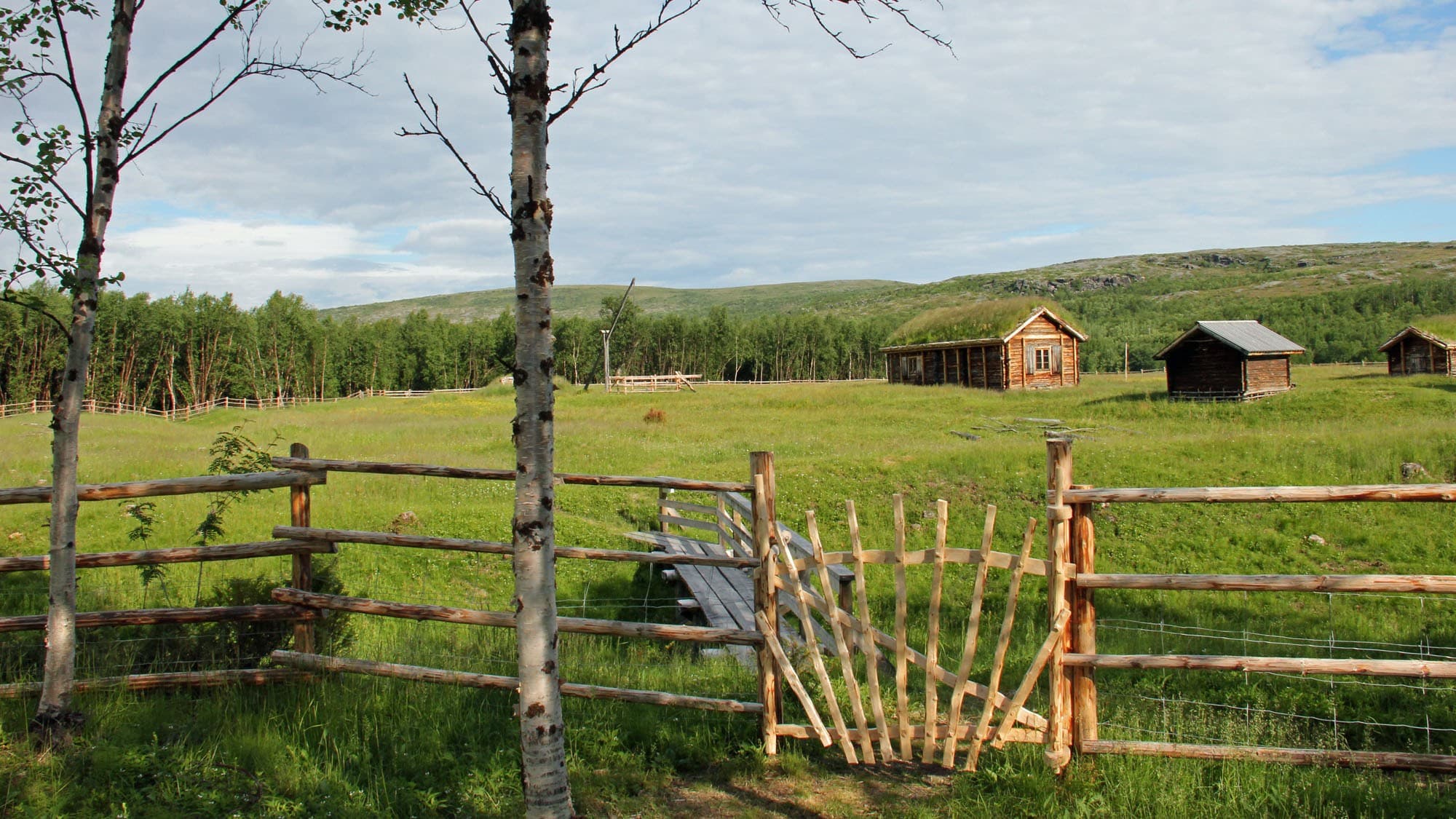Välimaa Sámi Farm
The Välimaa Sámi Farm is situated in a beautiful setting on the River Teno. Here, you can visit a genuine Sámi Farm in the extreme north of Finland. The buildings are locked but the farmyard is open for visitors.The farm is easiest to explore when there is no snow on the ground. The lay-by about 300 metres away from the farm is maintained by the road authorities, even in winter.
Ethnological jewel
The Välimaa Farm was founded in 1858, but there are traces of even earlier settlements on the site. With its timber and turf buildings, the Välimaa Farm, which is still on its original site, is a prime, nationally important example of an old Sámi farm based on river fishing and rearing sheep. This rare complex is one of the finest historical sights in Utsjoki and a unique ethnological jewel.
Vegetation on the Välimaa Sámi Farm
The grounds of the old Välimaa Sámi Farm are primarily dry and fresh hay meadows dominated by tufted hair-grass, sheep's fescue, common yarrow, European goldenrod and Arctic bramble. There is dry heath field closer to the shore. The field has been cleared of trees and saplings, thus opening a view of the Teno River. The field is now taken care of by sheep in the summer, which are owned by the lucky shepherds selected for the shepherding weeks.
Some of the endangered species growing in the Välimaa field are the threatened grape-fern, the near-threatened leathery grapefern and common moonwort, and chives. Flying above the vegetation, visi-tors might spot the near-threatened woodland ringlet butterfly. Noteworthy species also include the tall Jacob's ladder, Alpine bistort, garden speedwell and globeflower.
The birch grove next to the Välimaa home meadow is enormous in view of the circumstances. In fact, at around 300 years old, these birch trees are thought to be the oldest in eastern Finnmark.
History of the Välimaa Sámi Farm
Välimaa is a fine example of an old Sámi farm, where fishing and cattle husbandry were the main sources of livelihood. The farmyard of this old Sámi farm on a grassland platform by the River Teno is home to historic buildings and the old foundations of Lapp huts.
An Ancient Base for Hunting and Fishing
The Välimaa Farm has long been used as a base for dwelling and fishing. Some fishermen who arrived to enjoy the bounty of the River Teno stayed at the site where Välimaa Farm now stands. Proof of this is provided on the Välimaa farmyard by several foundations remaining from Lapp huts, or depressions left by dwellings. Although dating these remains is guesswork, the site has probably been inhabited since at least the 1600s, and possibly even since the Stone Age.
Life Close to Nature
Välimaa Farm was established in the Nuorgam village in Utsjoki in 1858, as a result of the declaration on the settlement of northernmost Lapland. The Swedish Crown reigned over the area as early as the 1700s, encouraging settlers to move to Lapland. During Russia's reign over Finland, the farm system that prevailed in other parts of the country spread to Lapland.
The Välimaa Farm was founded by Sámi fisherman Antti Jouninpoika Warsi near his father's meadows and traditional fishing waters. The farm's livelihood was based on fishing and the tending of livestock, mostly sheep. The barren natural conditions of the north did not support crop farming.
The buildings on the homestead represent the traditional building methods of the river Sámi people, being reminiscent of their ancient way of life close to nature. The fenced in farmyard contains a two-room house, a turf hut, a woodshed, a meat storage shed, a fish storage shed, a shed for fishing and hunting gear, a storage platform shed and a draw-well. Most buildings are made from timber, with a traditional turf or plank roof.
An Abandoned Farm Becomes a Landmark of Sámi Culture
The Warsi family lived on the Välimaa Farm until the 1970s. In 1981, the National Board of Antiquities bought the farm for preservation as a memorial introducing visitors to the river Sámi culture. Some of the buildings had already deteriorated due to being uninhabited, but have been repaired since.
The site is now administered and managed by Metsähallitus Parks & Wildlife Finland.
The recent years of the Välimaa Sámi farm
In the summer of 2015, the Natural Heritage Services of Metsähallitus renovated the buildings of the Välimaa farm and cleared the area. The structures in the worst condition were repaired. Metsähallitus also surveyed the vegetation in the yard and is preparing a maintenance plan for the area based on the survey.
In the autumn of 2015, the electrical installations of the farm were modernized. The renovated main building is kept at a basic temperature to ensure the roof and foundation structures remain in good condition.
In the summer of 2016, a WWF volunteer camp was held at the Välimaa farm. During the week, a pole fence was built around the farm and the overgrown field was cleared. New turf was acquired for the turf hut in the yard.
In the summer of 2017, the turfing of the turf hut was completed, and approach and destination signs were installed on the road.
Since 2017, sheep have been maintaining the traditional landscape of the farm's yard during the summer, and this successful nature management work will continue. The yard can also be visited during the shepherd weeks, but the buildings are not open to the public.
